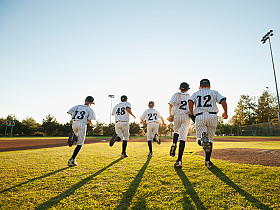Kids, Athletes & Blank
In what I do I receive a great number of coaching newsletters.
All of them are well-intentioned.
Some of them are really good.
However, most of them continue to promote the typical myths of youth sports.
And some of them are just crazy talk…
Here’s one from a couple of weeks ago that caught my attention. There is usually some good advice sprinkled in between all of the plugs to buy this guy’s training aids.
But not in this one.
“At my Coaches Clinics, the league provides 5 or 6 of their best young players to assist me in demonstrating drills. I have noticed they are mechanically very unsound. One of the biggest problems they have is that their legs are too weak to get into a proper fielding position. This means that even IF they can catch the ball, they will struggle to get their balance to get their legs under them and make an accurate throw. I’m not a big fan of wasting valuable practice time running because you don’t really need to be in great shape to play baseball but I might suggest drills to strengthen the legs that will result in much improved defense.”
This raises a few questions to me, and hopefully you as well.
Is it a waste of valuable practice time building an athlete first?
Are sport specific skills more important than building an overall athlete?
Is it true that you don’t don’t need to be in great shape to play baseball?
What does it take to be good at it?
If these are the best 5 or 6 players, what do the average kids look like?
Can they run to first base, or are they just waddling down there?
What has happened to the percentage of triples as hits over the years? Are there more doubles now because kids can’t run as far or as fast?
Would this be attributed to better pitching or coaches that profess “you don’t really need to be in great shape to play baseball?”
I am hoping that these are some of the same questions you had. And I am hoping that the coach’s quoted paragraph got you going as much as it did me. But what beliefs or principles do you have that someone else might look at as “crazy?” Are there things that you do in your normal practice that wouldn’t be so normal anywhere else? How much of that is just your style and personality coming through and how much of that is sound coaching and child development focused?
It is our belief, rooted in science, that there are some fundamentals of development that need to be incorporated into your programs to make sure they are on the right path to encourage long-term participation and athlete development. We see it like this:
1. kids/people
2. athletes
3. baseball players
tennis players
soccer players
Kids, athletes and (blank) players.
Kids
It is important to understand and show by evidence of what you do in practice that the kids, the little people in your program, are seen as just that. Little people.
They are not you.
They may not have the same motivations as you.
They may not have the same talent as you.
(many of them may actually have more)
They may not have the same learning style as you.
Their attention spans are shorter. (generally, and you know who you are…)
Their ability to process information is slower than yours.
Their muscles, bodies and brains are still growing and developing.
They are not your little pawns to be ordered around to make you look good.
They are not your ticket out of anywhere.
You are your only ticket out of wherever you are!
They are kids.
Little people.
Growing.
Laughing.
Learning.
Making mistakes (because that’s how we learn).
And watching your every move; learning more by what you do and how you say it, than what you say.
So what are you teaching in practice?
What are you doing that is wasting valuable practice time?
What could you be doing differently?
Athletes
Contrary to the advice of the quoted baseball coach, it is crucial that the kids in your programs move, practice and demonstrate basic athletic skills. The Long-Term Athletic Development model, or LTAD, talks about developing the ABC’s or agility, balance, coordination and speed, first. These are the foundation of all athletic skills. It’s not up to someone else to develop this. It’s your job. Teach, and practice this.
Too many coaches, and parents, believe that early specialization is the key to athletic performance. There is NO evidence to support this! In fact, there is great evidence to refute it. You truly are limiting the potential of the child to perform at their highest capability by having them focus on one sport at an early age. (there are a couple of “early maturing sports” like gymnastics where younger athletes are at their peak, but it is very rare)
A new program developed by USA Hockey called the American Development Model, based on the principles of the LTAD, has recently been launched and is brilliant! USA Hockey understands the growth and development of the child in broad terms at early ages to become hockey players later. Their “This is hockey” video says it all and can be found at this link.
http://www.admkids.com/media.php
(blank) players
Once you have focused on the child and their development and teach, practice and they can demonstrate general athletic movement and skill, then you are ready to create a baseball, hockey, tennis, basketball, etc…player. Focusing on children, their development, and general athleticism are prerequisites for performance, and especially long-term performance.
To put it another way, the better your child is at earlier ages (gymnastics and other early maturing sports aside) the less likely they are to succeed at their prime ages. We regularly see parents and coaches pushing kids at earlier and earlier ages for club, travel team or personal bragging rights over the longer-term interest of the child.
Our US athletic systems rewards early maturers, those kids that are a little bigger than their peers at age 8-10 and those born in the first half of the year in many sports, while 75% of Olympians are late maturers. The number one competitor for any junior athlete that must be recognized, and strategized against, is NOT other junior players, but BURNOUT spurred on by the coach, and most often parents.
To pick on baseball a little more, there is an example of a dad that believed his son could pitch more than the mandatory pitch limits imposed by youth baseball. He was probably well-intentioned, thinking he was helping strengthen his 12 year-old son’s arm. So the dad got around the rules by enrolling his son in four different leagues! His son wasn’t pitching every couple of days, he was pitching every day, and by 14 needed surgery. How about that for bragging rights? Is it worth it? And by 16 didn’t want to have anything to do with baseball and developed a hatred of his dad because of what he had done to him.
Conclusion
It really is time to take a serious look at what we are doing to our kids under the guise of doing something for our kids.
The most successful people and athletes are self-motivated!
As coaches and parents we can’t buy our kids performance, talent or desire. They have to do it. It truly is up to them.
So relax, sit back and enjoy the game. Or better yet, drop your child off and let them enjoy the game!














